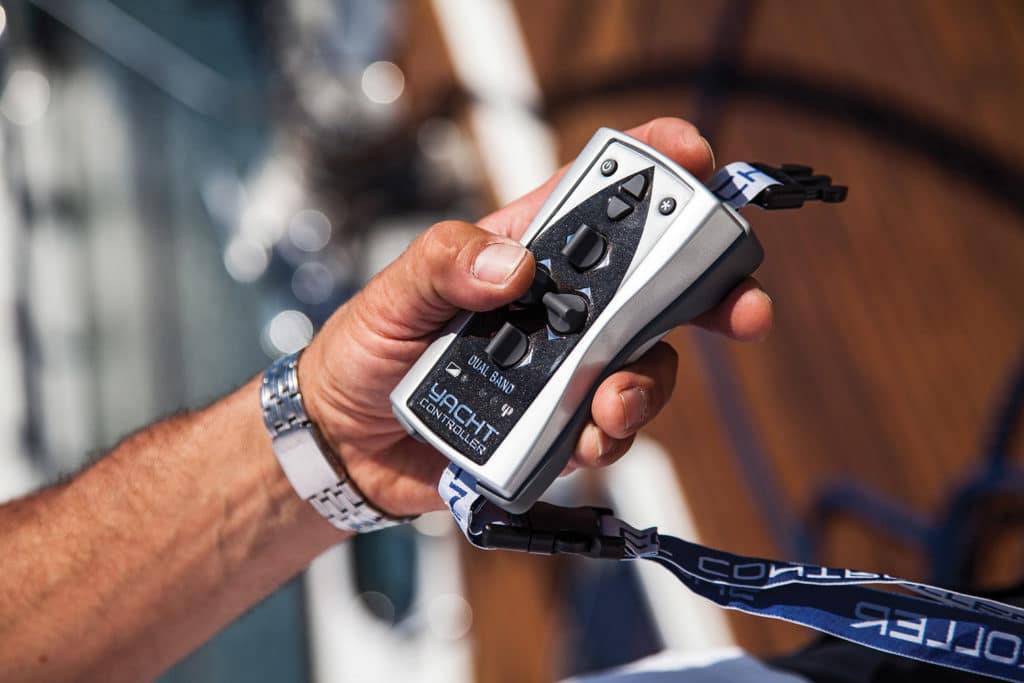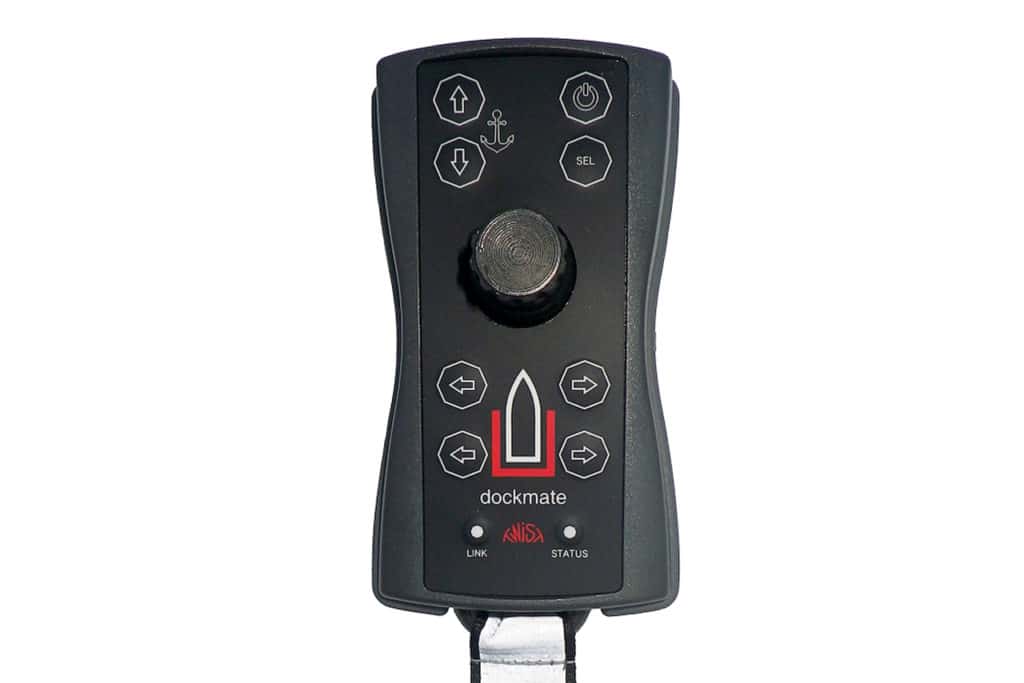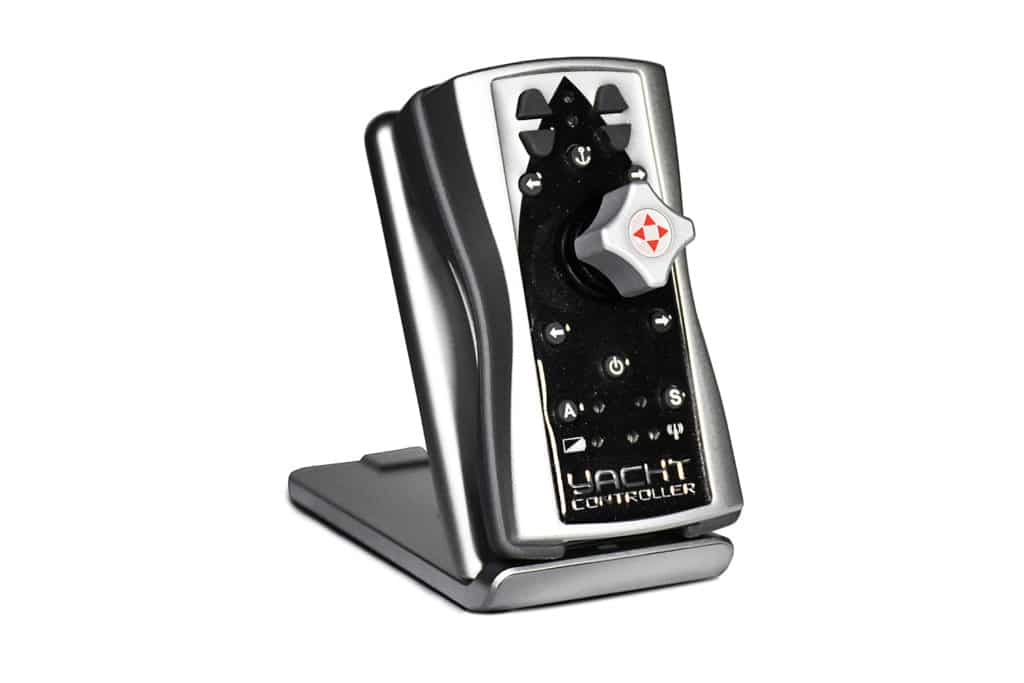
An earnest crosswind piped across the waters off Florida’s Virginia Key, where the Miami International Boat Show was well underway. Victor Avila, Dockmate’s chief technical specialist, handed me a Dockmate wireless device and control of the Topaz 27 center-console—in clear view of several thousand spectators. As a lifelong sailor who’s shy about docking powerboats, I felt mild trepidation, but the system was so intuitive that I quickly got comfortable spinning circles and performing other maneuvers using the controller and, through it, the Topaz’s single screw and bow and stern thrusters.
Crosswinds, currents and skinny margins for error: At its brightest hour, docking is an art form. At its darkest, it’s a public shaming that so often comes with a memorable yard bill or marriage counseling (or, worse still, the hat trick). I had to agree that while wireless vessel controls aren’t mandatory safety equipment, they do make docking easier, safer and more intuitive.
At their core, today’s vessel-control systems, including Dockmate and Yacht Controller, consist of a wireless transmitter (the controller), a black-box receiver and a set of connecting cables. This hardware runs on sophisticated software that typically integrates directly with existing engine controls to deliver handheld wireless command of the yacht, so long as the transmitter is within range of the receiver. While each system differs, most wireless ones give operators command over the yacht’s engines or pod drives, bow and stern thrusters, anchor windlass, and horn. Additionally, some systems allow users to control peripheral devices such as passerelles or swimplatform elevators.
“The chief benefit is that boaters [can] leave the helm and have a closer look and still be in control with a transmitter that gives the same response and feel as [their] wired controls,” says Brian Sheehan, Dockmate’s spokesperson. “This is important in tight quarters.”
These systems can deliver fine motor control over a boat, allowing operators to slot a vessel into its berth smoothly, while freeing them to assist with docking duties.
“These aren’t cars: We’ve got wind and tide, and we’re always moving,” says Jerry Berton, president of The Yacht Group, which manufacturers the Yacht Controller. “Yacht Controller enables you to move the boat in any direction in as little as 1 inch at a time.”

A device’s interface controls typically include buttons, joysticks and/or levers, with joysticks being the newest and most intuitive version. User commands are transmitted to the system’s black-box receiver via one or more radio frequencies. In turn, the system’s receiver shares the commands with the vessel’s engines and systems.
“We’ve designed cables that are very similar to the manufacturers’ [cables], but we added a Y-splitter cable,” Sheehan says. “One line goes to [the vessel’s] existing controls, and one line goes to our receiver, and [our system] takes it from there, using analog modules and CAN bus interfaces.”
A new system being able to connect to a vessel’s existing controls is key.
“Manufacturers have spent fortunes making electronic processors that control the engines and throttles, and we do not want to bypass these,” Berton says.
Safety is paramount any time mission-critical commands are transmitted over radio frequencies, especially in crowded marinas with competing RF signals. Dockmate operates on the 433 megahertz frequency over five different channels using a military-grade, frequency-hopping spread spectrum system, and each Dockmate transmitter is coded to match its receiver (think automotive fobs). Conversely, Yacht Controller is a dual-band system alternating between the 433 MHz and 916 MHz frequencies, and derivations thereof, every one-sixteenth of a second.

While their frequencies and features differ, wireless vessel-control systems work with most single- and twin-screw inboards, as well as pod-style drives and some outboards. Also, these systems generally use incremental throttle controls for inboards, but proportional controls are available for yachts with pod-style drives and/or proportional thrusters.
Engine type aside, wireless vessel control systems untether operators from the helm, allowing them to put eyeballs on the right bits of brine. While this ability adds utility and safety, these systems have narrowly defined onboard roles. ¶ “It’s only for docking,” says Sheehan, adding that the system is also useful for performing other low-speed, high-precision maneuvers such as anchoring, retrieving a man overboard, collecting crab traps or helping an angler land a pelagic prize. “We purposefully dialed back the rpm to a maximum of 30 percent of the engine’s capacity to keep boaters from using it for other means.”
Such authority settings can sometimes be custom-configured, however, Berton offers a cautionary note: “When you start going 5 knots [in a marina], your chances of accidents are high. The majority of the time, you’re going less than 5 knots.”
As with any crucial system, these require yacht owners to set up a sea trial to familiarize themselves and to identify vessel-specific customizations. For example, Sheehan says, Dockmate installers can dial down the bow thruster rpm to match the vessel’s stern thruster or modify the throttle governor.
Overall, yacht owners can expect far less stressful docking and easier close-quarters maneuvering—and, potentially, the ability to do short- or singlehanded cruising.
“People can run their boat, and they can tie it up by themselves,” Berton says. “This allows them to enjoy boating without grief, and it can be a marriage saver.”








